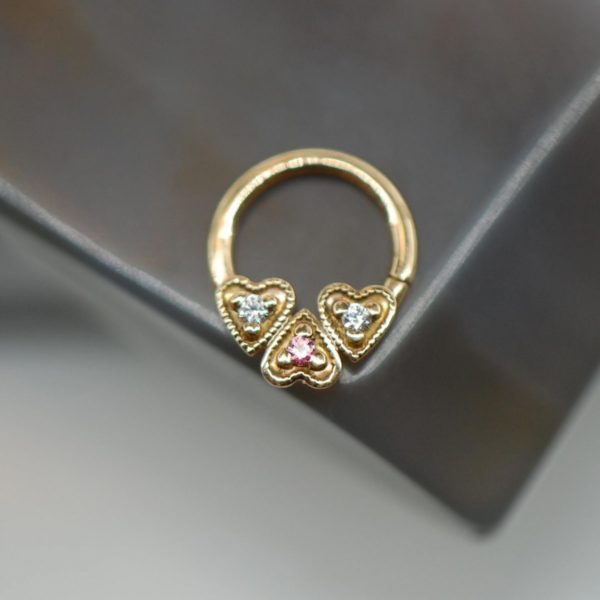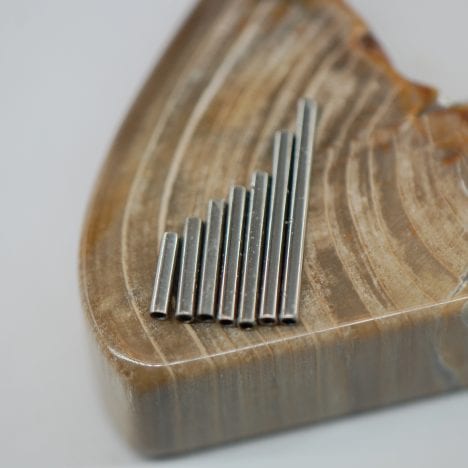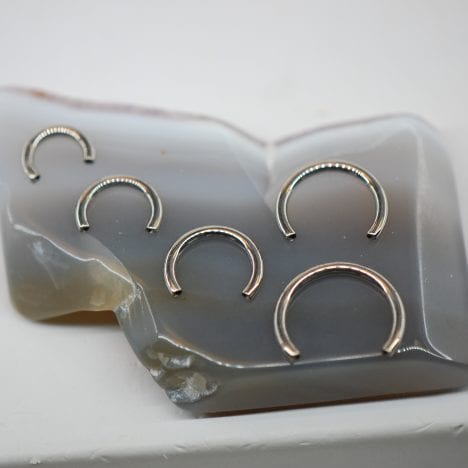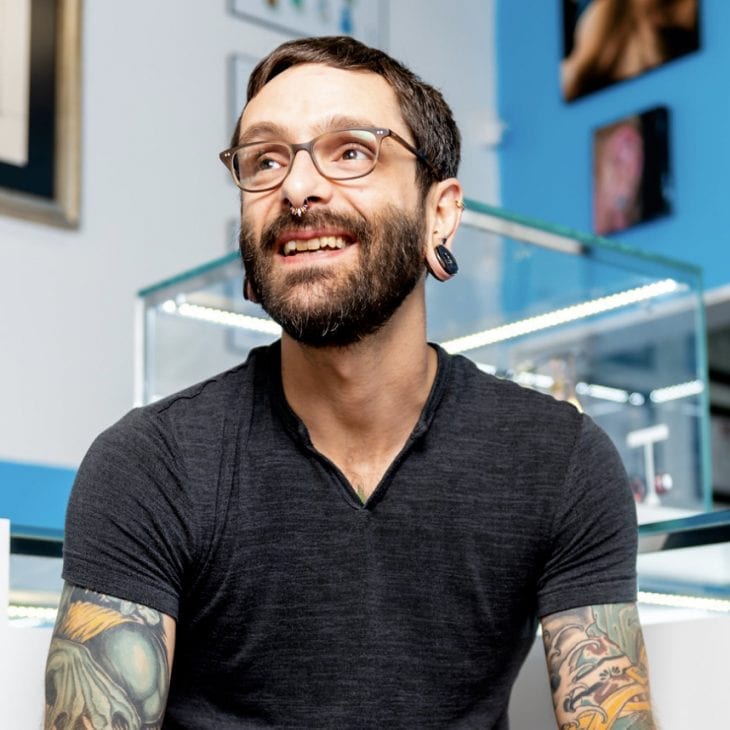One of our favorite things we get to do here at Amato is ear curations! Often times, these projects require 3 or 4 (or 5 or 6…) new piercings to help complete the look a client wishes to achieve. With everything all planned out, it’s understandable to want to just jump into it head first and get all those piercings done at once for that sweet instant gratification. Trust us when we say, we understand how addictive a new sparkly piercing can be. Unfortunately, as the saying goes, you can certainly have too much of a good thing. Having multiple piercings healing all at once can spell disaster for that “ear goal” you’ve been dreaming of. Piercings teach you many things, but most often they teach you patience and our piercers here are big supporters of taking things slow! To help further reinforce why it’s better to take your time when getting pierced, we’ve gone ahead and outlined just exactly why we say “No” to new piercings so often.
We’re incredibly passionate about client education which is why we’ve chosen to detail what we consider some of the most important aspects of getting pierced; wound healing! There are three phases of wound healing that the body goes through when you get a cut or scrape etc; but your body also goes through these phases when you get a new piercing. So as to keep it simple, we’ve cut down on all the lengthy scientific explanations to give you the bare basics of what’s best to know. We will cite all reputable sources of information towards the end so if you choose to further dive into the awesome science that is our body’s lymphatic system, you’re welcome to do so!
Stage 1 – Inflammation:
This is the body’s first response to injury and a new piercing is exactly that! During this stage, the blood vessels around the inflicted area (I.E. around the piercing site) will dilate to allow blood, carrying things like white blood cells and other immune responsive components, to reach the wound and protect the body from initial infection. The widening of blood vessels is what causes the area around your piercings to become swollen, warm and red.
Stage 2 – Proliferation:
This is the rebuilding stage. As a piercing nears the end of it’s initial inflammatory phase, it will start the process of repopulating the area with new, healthy cells. You may notice during this phase that there is an increase of liquid secretions that begin coming out of your piercing; these liquid secretions may also dry quickly and present themselves as flaky crust instead. This is all perfectly normal and is actually a good thing! That gooey clearish white stuff you’re seeing often consists of things like collagen that continue to help strengthen the surrounding tissue. You may also notice during this stage that the piercing site itself has become less swollen, but is still a little pink in color. This pink coloration means the piercing is healthy but still repairing itself. If for some reason the piercing tissue appears much darker in coloration, this can mean the body is having difficulty repairing the tissue and is still somewhat in phase one.
Stage 3 – Maturation:
This is also known as the remodeling phase. As the last phase of wound healing, this is essentially when your body begins to cross it’s T’s and dot it’s I’s. Your body will severely decrease the amount of reparative cells its been sending to the wound (your piercing) and works on fully strengthening the tissue that was built during phase two. You will now notice little to no secretions exiting the piercing, and your piercing will begin to settle from a subtle pink to a normal flesh tone once more. It’s important to note that the process of maturation of a wound varies dramatically and can last an extended amount of time so remember not to take your healed piercings for granted! Within the first two years of healing, even an unagitated piercing can become inflamed under the right conditions if the cells and tissue surrounding it are still somewhat weak.
With all that being said, the question now is: how does this play into you getting an ear full of new piercings? Well, when it comes to body-piercings, the body doesn’t always follow those three stages of wound healing as it should. In fact, body-piercings often break many rules of wound healing just simply due to the fact that we’re leaving an unknown “object” (the jewelry) in the body as it tries to do its job and heal your injury around it. The time frames that these phases happen in and in what order they happen in becomes an extremely gray area when you’re dealing with something as abnormal as a body piercing. It’s not every day that you ask your body to do something it isn’t predisposed to doing. This means we as piercers see a lot of “strange and unusual” aspects of these healing phases. It’s not uncommon to see the body regress stages while a piercing is healing, sometimes this regression can even happen more than a few times. It’s also not uncommon to see the body over-respond to the wound site, resulting in things like hypertrophic scars. A vast and strong foundation of knowledge regarding the lymphatic system and wound healing is the basis of what allows us as piercers, to help you as client’s, heal those lovely piercings! It’s never expected to have this plethora of information already in your brain bank from the beginning, but moving forward it helps to know just how and why things happen.
Now knowing the fundamentals of how the body responds to injury, we can highlight the main factor that has us encouraging you to wait for that extra new piercing. As discussed above, the body responds to a wound with inflammation. This phase plays a key role in protecting you from infection, however this response can be detrimental to a healing piercing if it becomes excessive or remains for a long period of time. A surplus of inflammation can actually disrupt normal immune function by focusing the immune system in that one affected area. This dysregulation of your body’s typical response is a well known cause of the development of scarring as well as creates an environment where your body is more susceptible to bacteria and other outside elements. It has been recommended by healthcare professionals to reduce inflammation as much as possible so as to prevent such scenarios. This includes limiting yourself on the number of piercings you get done in one sitting! Your body’s immune system is capable of many amazing things but can very easily be overwhelmed. That can lead to some pretty disappointing piercing results. If you were to do 4 or 5 new piercings within close proximity of one another, you greatly increase the amount of inflammation that portion of the body will experience, which in turn greatly increases your immune response to such a concentrated area. This over concentration of inflammation can slow down the rate at which your piercings heal. It’s easy to understand if you imagine each piercing as if it were a crying newborn baby; one or two crying babies is manageable but add in a few more and you’ve got your hands full with no way to help all of them at once. One and/or all of your babies could end up really upset without your attention! This is why we as piercers, never choose to pierce too much at one time. Knowing what piercings swell in what way, allows us to safely limit clients so we can ensure you have a smooth road during healing. I promise we’re not trying to be mean by telling you “No”, but instead we realize the issues that come with having multiple piercings in that initial inflammation phase.
If you’re someone who just can’t stand to wait another couple of months to add something new, here are a few easy steps you can take to aid your lymphatic system during the healing process. By following these guidelines, you’ll set yourself up for a smoother and potentially quicker heal!
Reduce Your Stressors
Stress and anxiety have been found to weaken the immune system. Try to remove major stressors and/or find a constructive outlet that may allow you to overall reduce the amount of emotional unrest you’re experiencing. We understand this isn’t always viable for everyone, but it should be said that a healthy mind often leads to a healthy body! One of the more specific times we see clients come in with piercing issues is during midterms, finals, and standardized testing periods; understandably so knowing those times are often stressful for all involved. Some of our favorite ways to take a breather include playing with our fur-babies, going to concerts, and playing video games!
Maintain A Healthy Diet
One thing that happens as a piercing heals is the production of collagen and other healthy stabilizing tissue cells. Keeping a balanced diet allows your body the ability to help with the production of such things. If you’re someone who has dietary restrictions or preferences that may limit your intake of certain daily nutritional aspects, try finding supplemental versions to fill those gaps! Your overall physical health contributes to the health of your skin and the rate at which your body repairs itself. Staying hydrated is also an important factor, so be sure to drink plenty of water throughout the day.
Sleep Well
Although this goes without saying, it’s crucial to find a sleep schedule that is appropriate for your lifestyle! Lack of sleep can lead to a variety of things, but in this context, we want to reiterate that lack of sleep can reduce the function of your immune system. It’s easy to fuss up your sleep schedule with late nights at the office and those rom-com movie marathons, but try and rest up. You’ll thank us for the reminder! Being armed with an overall awareness of what goes into how a piercing heals will only further help you reach the end of your piercing journey. With piercings must come patience, and with patience comes an abundance of healed and happy work!
Advanced Tissue. (2019). Understanding the Healing Stages of Wounds – Advanced Tissue. Available at: https://advancedtissue.com/2014/08/understanding-healing-stages-wounds/ . https://www.apa.org. (2019). Stress Weakens the Immune System. Available at: https://www.apa.org/research/action/immune . WoundSource. (2019). Wounds and the Lymphatic System. Available at: https://www.woundsource.com/blog/wounds-and-lymphatic-system . https://www.ncbi.nlm.nih.gov/pubmed/29984112





